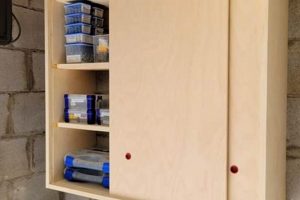A prefabricated set containing the necessary components for individuals to independently install or replace a garage door. This typically includes the door panels, tracks, springs, rollers, hinges, and hardware, along with instructions intended to guide the installation process. The completeness of the kit varies depending on the manufacturer and model, some may require purchasing additional tools or materials separately.
The availability of such kits offers several advantages. It can reduce expenses by eliminating professional installation fees, while also providing homeowners with a sense of accomplishment. Historically, garage door installation required specialized skills. These kits have democratized the process to some extent, empowering individuals with basic mechanical aptitude to undertake the task. The benefit of self-installation, including scheduling flexibility and potential customization options, can be a significant draw.
The subsequent discussion will delve into specific aspects of these offerings. It will cover the different types available, the factors one should consider before undertaking a self-installation project, a breakdown of typical component inclusions, and the safety precautions essential during the entire process.
Installation Recommendations
Successful installation hinges on thorough planning and meticulous execution. The following recommendations are crucial for those undertaking such a project.
Tip 1: Consult Instructions Meticulously: Prior to commencing any physical work, thoroughly review the entirety of the included documentation. Understand each step and associated safety warnings. Any ambiguity should be resolved by contacting the manufacturer’s support resources.
Tip 2: Conduct a Preliminary Inventory: Before disassembling the existing door, verify that all components listed in the inventory manifest are present and undamaged. Missing or damaged parts can impede progress and potentially compromise the installation’s integrity.
Tip 3: Employ Appropriate Safety Measures: Garage door springs store a considerable amount of energy. Always wear appropriate safety glasses and heavy-duty gloves. Disconnect the power supply to the garage door opener prior to commencing work.
Tip 4: Ensure Compatibility: Verify that the product purchased is appropriately sized and configured for the existing garage door opening. Consider factors such as headroom, sideroom, and backroom, as well as the weight of the intended replacement.
Tip 5: Prepare the Workspace: Clear the garage floor of any obstructions, and ensure adequate lighting. A clean and organized workspace will contribute to a safer and more efficient installation process.
Tip 6: Seek Assistance if Needed: If encountering significant difficulty or uncertainty during any stage of the installation, it is advisable to consult with a qualified professional. Attempting to force components or bypassing safety protocols can lead to serious injury or property damage.
Adherence to these recommendations will promote a safer, more efficient, and ultimately more successful endeavor. It underscores the importance of meticulous planning, safety consciousness, and a realistic assessment of one’s capabilities.
Subsequent sections will address common challenges encountered during this process and offer troubleshooting guidance.
1. Component Quality
The correlation between the inherent quality of components and the overall performance of a self-installed garage door system is direct and significant. Lower-grade materials, such as thinner gauge steel in door panels or weaker spring alloys, can lead to premature failure, compromised security, and increased maintenance requirements. For instance, a DIY garage door installed with low-quality rollers may exhibit noisy operation and reduced lifespan, necessitating frequent replacements and potentially damaging the tracks over time. Substandard hinges can weaken, leading to door panel separation and rendering the door inoperable. Furthermore, the use of insufficiently tempered springs can result in early fatigue and breakage, creating a hazardous situation and requiring immediate professional attention.
The selection of a kit with robust, durable components mitigates these risks. Higher-quality steel panels offer increased resistance to denting and corrosion, contributing to a longer-lasting, aesthetically pleasing door. Sturdier hinges provide enhanced structural integrity, while premium rollers ensure smooth, quiet operation and minimize wear on the track system. Selecting springs made from high-tensile steel guarantees greater longevity and a more consistent counterbalance, reducing the strain on the garage door opener and improving overall system reliability. The initial investment in a kit featuring superior components translates to long-term cost savings by minimizing repairs and replacements.
In conclusion, component quality is not merely a desirable attribute but a fundamental prerequisite for a successful self-installation endeavor. Opting for a product that prioritizes durable materials and robust construction is crucial for ensuring the long-term performance, safety, and security of the garage door system. Skimping on component quality can lead to a cascade of problems, ultimately negating any perceived cost savings from the initial purchase.
2. Spring Tension
Spring tension is a critical element in any garage door system, especially within the context of a self-installation. It provides the counterbalance necessary for safe and efficient operation, effectively managing the weight of the door during opening and closing. Imbalance in this tension can lead to operational difficulties, safety hazards, and premature component wear.
- Proper Weight Balancing
Spring tension directly dictates the counterbalance force applied to the garage door. If the tension is insufficient, the door will be heavy and difficult to lift manually, placing undue strain on the opener motor. Conversely, excessive tension can cause the door to rise too quickly, potentially leading to damage or injury. A correctly balanced door should remain stationary at any point along its travel, indicating proper spring tension adjustment.
- Safety Implications
Garage door springs store a significant amount of potential energy. Incorrectly installed or adjusted springs can pose a serious safety risk. If a spring breaks under tension, it can recoil with considerable force, potentially causing severe injury or property damage. Safety cables, often included, are essential to restrain the spring in the event of breakage, mitigating this hazard. DIY installation necessitates careful adherence to safety protocols to avoid accidental spring release during tensioning.
- Spring Types and Selection
Torsion springs and extension springs are the two primary types used in garage door systems. Torsion springs mount above the door and use torque to provide counterbalance, while extension springs are located along the sides of the door and extend to provide force. The selection of the correct spring type and size is crucial for proper operation. Factors such as door weight, height, and track configuration influence spring selection. The replacement of existing springs in a DIY capacity requires accurate identification of the original spring specifications to ensure compatibility and safe operation.
- Adjustment Procedures
Achieving the correct spring tension often requires adjustment after installation. Torsion springs are adjusted by winding or unwinding them on a torsion tube, while extension springs are adjusted by moving their position on the track. These adjustments must be performed carefully and methodically, following the manufacturer’s instructions. Improper adjustment can lead to the issues mentioned above. DIY installers must exercise caution and possess the necessary tools, such as winding bars for torsion springs, to perform these adjustments safely.
In summary, spring tension represents a fundamental aspect of a self-installed garage door system. Proper selection, installation, and adjustment are essential for ensuring safe, reliable, and efficient operation. Failure to address this element adequately can result in significant performance issues and potentially hazardous conditions. DIY installers should prioritize understanding the principles of spring tension and adhering to safety guidelines to mitigate these risks.
3. Track Alignment
Track alignment is a critical determinant of a garage door’s functionality and longevity, especially when considering a self-installation. The tracks guide the door’s vertical movement, and any deviation from precise alignment can introduce operational inefficiencies, safety hazards, and premature wear. In the context of a product offering, precise track alignment is non-negotiable.
- Operational Smoothness
Misaligned tracks impede smooth door operation. Binding, uneven movement, and increased noise levels are common symptoms. For instance, if one track is slightly higher than the other, the door rollers may encounter resistance, causing jerky movements and accelerating wear on both the rollers and the track itself. This lack of smoothness can ultimately shorten the lifespan of the door opener and necessitate more frequent maintenance.
- Stress Distribution
Properly aligned tracks ensure even stress distribution across the door panels and supporting hardware. Misalignment concentrates stress on specific points, potentially leading to panel warping, hinge failure, or even track detachment. Consider a situation where the vertical track is not perfectly plumb; the door weight will be unevenly distributed, stressing the lower hinges and potentially causing them to fail prematurely. Accurate track alignment mitigates such risks, promoting a longer lifespan for all components.
- Safety Implications
Deviations from correct track alignment can compromise the safety mechanisms of the door. Safety sensors, designed to prevent the door from closing on obstructions, may malfunction if the door encounters undue resistance due to track misalignment. A door that is forced to operate against misaligned tracks can also place excessive strain on the opener, increasing the risk of opener failure and potential uncontrolled door movement. Therefore, precise alignment is essential for the reliable operation of safety features.
- Installation Challenges
Self-installation presents specific challenges related to track alignment. Minor imperfections in wall surfaces or variations in mounting point locations can easily introduce misalignment. Furthermore, imprecise measurements or inadequate leveling during the installation process can exacerbate these issues. Accurate measurements, careful leveling, and shimming techniques are essential to overcome these challenges and achieve proper track alignment.
The interconnectedness of these elements underscores the importance of meticulous attention to track alignment during a self-installation project. Failing to achieve accurate alignment can negate the perceived cost savings of a self-installation and result in significant performance issues, safety risks, and ultimately, the need for professional intervention.
4. Opener Compatibility
The functionality of a “diy garage door kit” is inextricably linked to opener compatibility. The garage door opener provides the automated force for raising and lowering the door, and its proper integration with the newly installed door is crucial for safe and reliable operation. Selecting a product without verifying this compatibility can lead to performance issues, safety risks, or the complete inability to automate the door. The weight of the new door, spring tension system, and mounting hardware configuration must be suitable for the existing or intended opener. A mismatch can overstress the opener motor, cause premature failure, or even lead to the door becoming detached during operation. As an example, a lightweight opener paired with a heavy, insulated door could struggle to lift the door consistently, potentially damaging the opener or door components.
Furthermore, opener compatibility extends beyond mere weight considerations. The door’s track system and roller type must be compatible with the opener’s drive mechanism, whether it is chain-drive, belt-drive, or screw-drive. Incompatibilities in these areas can create excessive friction, noise, and wear. Safety features, such as automatic reversal upon obstruction, also rely on proper integration between the door and the opener. Some kits may necessitate specific adapter brackets or wiring harnesses to interface correctly with particular opener models, adding to the complexity of the installation process. Verification of compatibility often involves consulting the opener’s specifications, the kit’s documentation, or seeking guidance from the manufacturer’s support channels. Installation without proper verification can result in a malfunctioning system and necessitate costly rework.
In conclusion, opener compatibility constitutes a fundamental aspect of “diy garage door kit” selection and installation. Consideration extends beyond simple weight assessments to encompass track compatibility, drive mechanism alignment, and safety feature integration. Thorough verification prevents operational problems, enhances safety, and maximizes the lifespan of both the door and the opener. Prioritizing compatibility ensures that the self-installation project results in a fully functional and reliable automated garage door system.
5. Safety Mechanisms
The integration of robust safety mechanisms is paramount within the context of a “diy garage door kit”. The inherent weight and mechanical complexity of a garage door system pose potential hazards. Consequently, careful consideration must be given to these mechanisms during both selection and installation to ensure user safety and prevent property damage.
- Photoelectric Sensors
Photoelectric sensors, commonly referred to as safety eyes, represent a critical safety component. These sensors, positioned near the bottom of the door opening, project an invisible beam across the threshold. Interruption of this beam during door closure triggers an immediate reversal, preventing the door from closing on obstructions, whether animate or inanimate. Proper alignment and functionality of these sensors are crucial; misalignment or damage can render the safety feature ineffective. An example of real-world relevance is the prevention of a garage door closing on a child or pet that has inadvertently wandered into the door’s path.
- Obstruction Detection Systems
Many garage door openers incorporate obstruction detection systems that monitor the force exerted during the closing process. If the door encounters an unexpected level of resistance, the system halts its descent and initiates a reversal. This mechanism supplements the protection offered by photoelectric sensors. Consider the scenario where an object, such as a trash can, is positioned too close to the closing door but is not detected by the safety eyes; the obstruction detection system would trigger a reversal, preventing potential damage to the door or the object.
- Emergency Release Mechanisms
In situations where power is lost or the opener malfunctions, an emergency release mechanism provides a manual means of disengaging the door from the opener. This typically involves a pull cord connected to a release lever on the opener carriage. Activating this mechanism allows the door to be raised or lowered manually. In the event of a fire or other emergency, a functioning emergency release allows occupants to quickly exit the garage, regardless of the opener’s operational status. Regular testing of the release mechanism is essential to ensure its functionality in emergency situations.
- Spring Restraint Systems
Garage door springs store a significant amount of potential energy, and their failure can result in dangerous projectiles. Spring restraint systems, such as safety cables threaded through extension springs, are designed to contain the spring in the event of breakage. These systems prevent the spring from recoiling uncontrollably, minimizing the risk of injury or property damage. While torsion springs inherently pose less of a projectile risk due to their mounting configuration, ensuring their proper installation and maintenance remains critical for overall system safety.
These safety mechanisms, when properly implemented and maintained, significantly reduce the risk associated with operating a garage door system. “diy garage door kit” installations necessitate a thorough understanding of these features, adherence to manufacturer’s instructions, and periodic inspection to ensure their continued functionality. Compromising on safety mechanisms to reduce cost or installation complexity is ill-advised and can have severe consequences.
Frequently Asked Questions
This section addresses common inquiries regarding self-installation. It aims to provide clear and concise answers to enhance understanding and inform decision-making.
Question 1: Are specialized tools required for a garage door kit installation?
Yes, certain specialized tools are typically necessary for successful installation. These may include winding bars for torsion springs, a level, a plumb bob, measuring tape, wrenches, sockets, and drills. The specific tool requirements can vary depending on the kit manufacturer and door type; therefore, consulting the installation manual is imperative before commencing the project.
Question 2: What safety precautions must be observed during the installation?
Safety is paramount. Disconnecting power to the garage door opener is crucial prior to starting. Eye protection and heavy-duty gloves should be worn at all times. Caution must be exercised when handling springs, as they store significant potential energy. Seeking professional assistance is recommended if unfamiliar with spring handling or tensioning procedures.
Question 3: How long does a typical self-installation take?
The duration can vary depending on experience level, kit complexity, and unforeseen challenges. However, a typical self-installation project can reasonably be expected to span one to two full days. Adequate time allocation is essential to avoid rushing the process and compromising safety or quality.
Question 4: Is a building permit required for a new garage door?
Permit requirements vary by locality. Consulting the local building department to determine permit requirements prior to commencing the project is advisable. Failure to obtain necessary permits can result in fines or mandated removal of the installed door.
Question 5: What factors influence the longevity of a self-installed garage door?
Several factors contribute to a door’s lifespan. Component quality, proper installation, and regular maintenance are all critical. Selecting a kit with durable materials and adhering to the manufacturer’s installation guidelines will maximize longevity. Periodic inspection and lubrication of moving parts will further extend its operational life.
Question 6: What are the common signs that a garage door spring needs replacement?
Signs of spring failure include difficulty opening or closing the door, uneven door movement, visible gaps or breaks in the spring coils, and excessive noise during operation. Addressing spring issues promptly is essential to prevent further damage and ensure safety. A qualified professional should perform spring replacement, particularly for torsion springs.
Proper planning, adherence to safety guidelines, and component quality contribute significantly to the success and longevity of a self-installed system. The information presented here serves as a foundation for informed decision-making.
The subsequent section will address troubleshooting steps for commonly encountered problems.
Conclusion
This exploration has underscored the multifaceted nature of the “diy garage door kit,” encompassing aspects from initial selection to long-term maintenance. The success of such an undertaking hinges on meticulous planning, a thorough understanding of component functionality, and unwavering adherence to safety protocols. Factors such as component quality, spring tension management, track alignment precision, opener compatibility, and the proper implementation of safety mechanisms directly influence the system’s overall performance, reliability, and, most importantly, safety.
The informed homeowner, armed with this knowledge, is better equipped to make sound decisions regarding the feasibility and execution of a self-installation. While the potential for cost savings and personal satisfaction exists, the complexities involved necessitate a realistic assessment of one’s skills and resources. Prudent consideration of these factors will contribute to a successful outcome and ensure the safe and reliable operation of the installed system for years to come. Prioritizing safety and understanding limitations remain paramount considerations.







